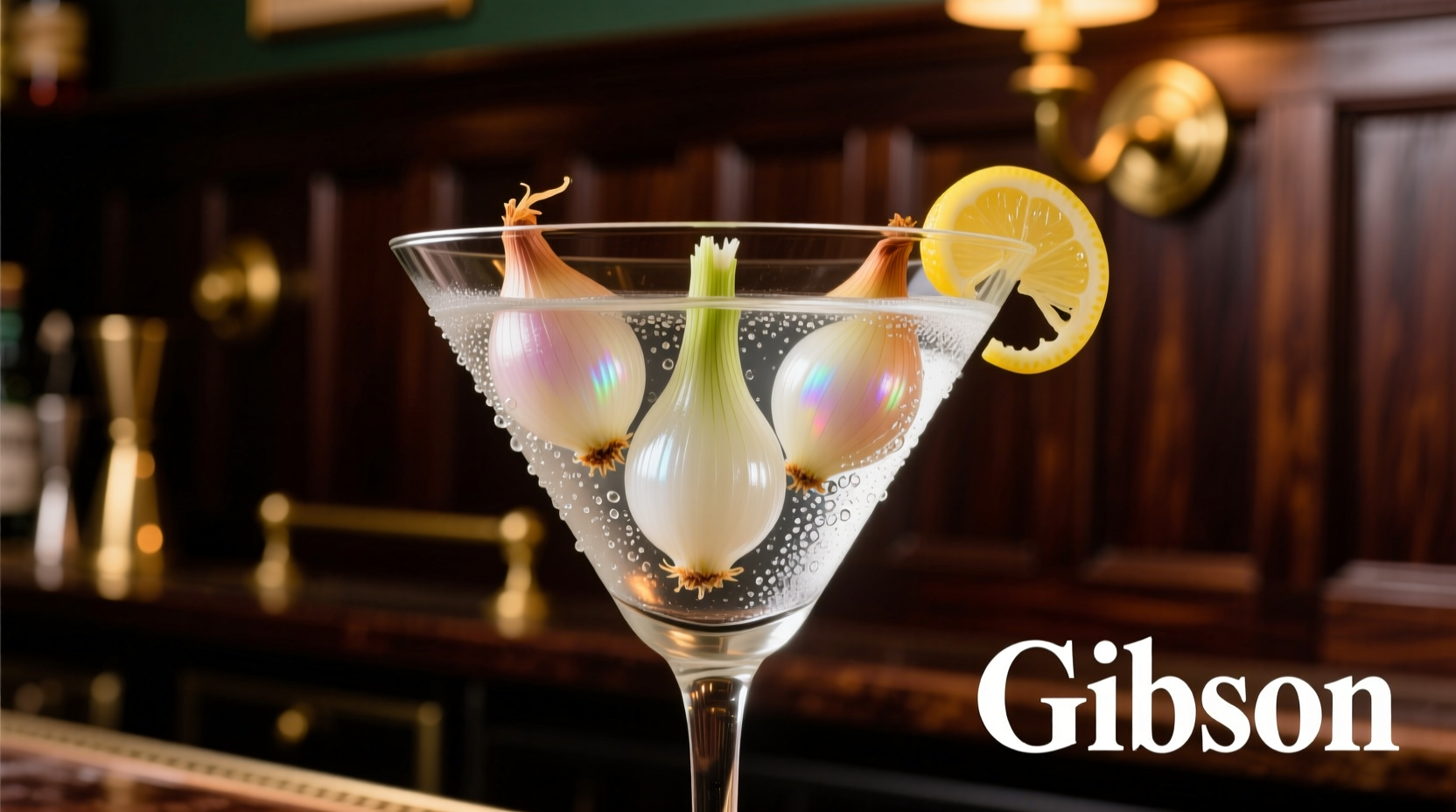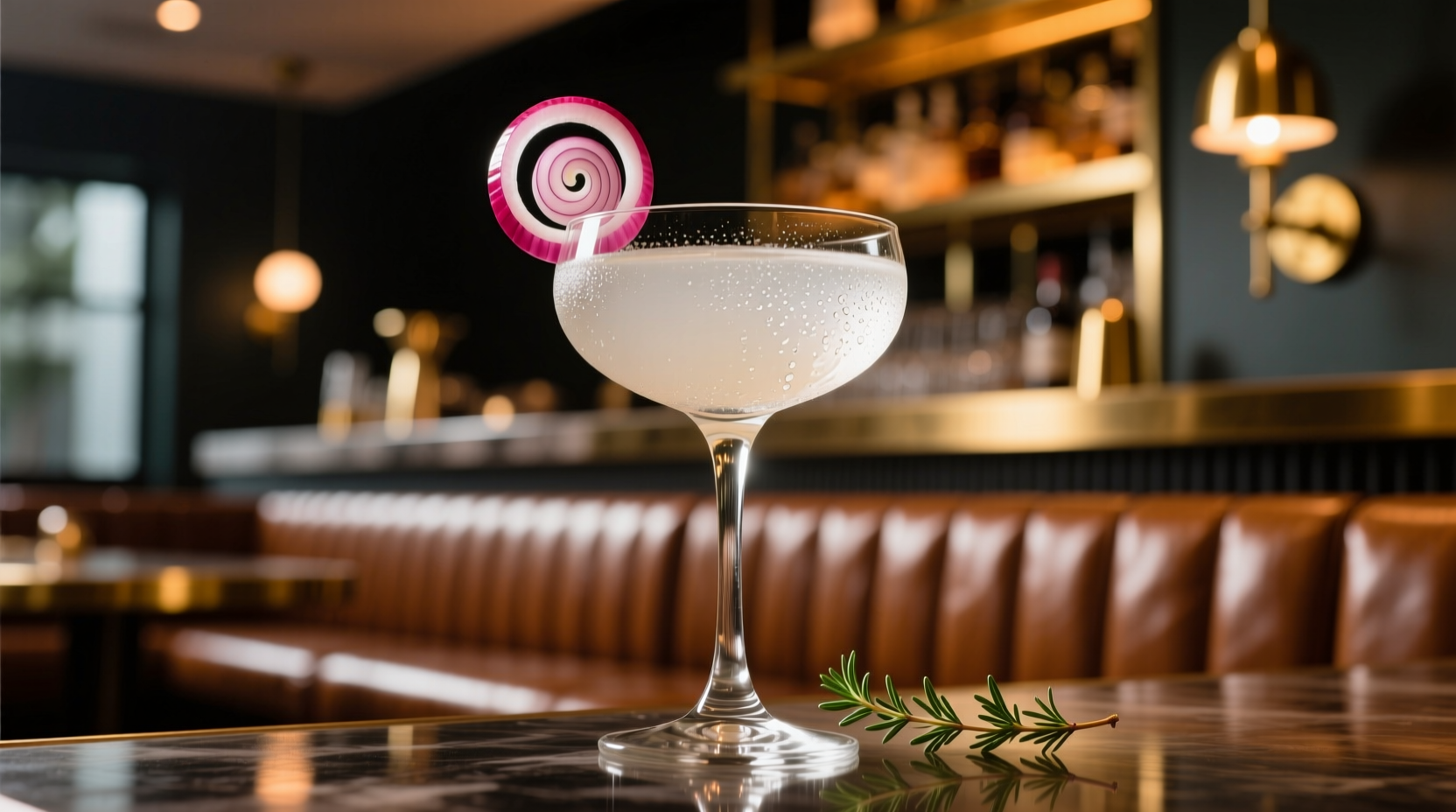Ever wondered why a simple substitution of garnish transforms an ordinary martini into something extraordinary? The onion martini—better known as the Gibson—represents one of cocktail history's most elegant evolutions. In this guide, you'll discover not just how to craft the perfect Gibson, but understand why this seemingly minor variation creates such a distinctive drinking experience.
The Gibson's Historical Evolution
Unlike many cocktails with murky origins, the Gibson's history has several documented theories. While often attributed to cartoonist Charles Dana Gibson, historical evidence points to earlier origins:
| Time Period | Key Development | Historical Evidence |
|---|---|---|
| 1890s | First documented references | Appears in The St. Paul Daily News (1898) as "cocktail with onion" |
| Early 1900s | Association with Charles Dana Gibson | Gibson allegedly bet a bartender he couldn't create a new cocktail |
| 1910s-1920s | Prohibition era popularity | Featured in Harry Craddock's Savoy Cocktail Book (1930) |
| Modern Era | Craft cocktail renaissance | Featured in International Bartenders Association official drinks list |
Why Onion Works: The Flavor Science
The magic of the Gibson lies in the chemical interaction between the onion's sulfur compounds and the botanicals in gin. According to flavor chemists at the University of California's Department of Viticulture and Enology, the mild sulfurous notes in pickled onions complement juniper's terpenes without overwhelming them—a perfect example of flavor pairing principles.
"The pickling process transforms raw onion's harsh sulfur compounds into more complex, mellow flavors that integrate beautifully with distilled spirits," explains Dr. Hildegarde Heymann, a leading flavor chemist. This scientific understanding explains why the Gibson remains popular while other onion-based cocktails have faded.
Perfecting Your Gibson: Step-by-Step Guide
Creating an exceptional Gibson requires attention to detail. Follow these professional techniques for cocktail perfection:
Essential Ingredients
- 2.5 oz premium gin (London dry works best) or vodka
- 0.5 oz dry vermouth (Chambéry or Dolin)
- 1-2 cocktail onions (preferably Pearl or cornichon-style)
- Optional: 1 dash orange bitters
Professional Preparation Method
- Chill a cocktail glass in the freezer for 10 minutes
- Add gin, vermouth, and bitters (if using) to a mixing glass
- Add ice (preferably a single large cube to minimize dilution)
- Stir gently for 30 seconds until properly chilled
- Strain into chilled glass
- Skewer onions on a cocktail pick and place in glass

Avoiding Common Gibson Mistakes
Even experienced home bartenders make these critical errors that compromise the Gibson's delicate balance:
| Mistake | Why It Matters | Professional Solution |
|---|---|---|
| Using regular yellow onions | Too pungent, overwhelms the drink | Use small pearl onions or cornichon-style cocktail onions |
| Over-stirring | Excessive dilution mutes flavors | Stir precisely 30 seconds with large ice cube |
| Incorrect vermouth ratio | Too much vermouth dominates | Maintain 5:1 spirit-to-vermouth ratio for classic preparation |
| Warm glass | Accelerates melting and dilution | Always chill glassware for at least 10 minutes |
Creative Variations Worth Trying
While purists prefer the classic preparation, these thoughtful variations showcase the Gibson's versatility:
The Modern Gibson
Substitute 0.25 oz of the vermouth with saline solution (4 parts water to 1 part salt) for enhanced mouthfeel without compromising the drink's clarity.
The Smoked Onion Gibson
Smoke the cocktail onions using a smoking gun with applewood chips for 30 seconds before adding to the drink. This technique, popularized by Chicago's The Aviary, adds subtle complexity without overpowering.
The Seasonal Approach
Adjust your Gibson based on the season:
- Spring/Summer: Lighter gin with citrus notes, minimal vermouth
- Fall/Winter: Fuller-bodied gin, slightly more vermouth for warmth
When to Serve a Gibson
The Gibson's subtle savory profile makes it uniquely versatile. According to the Spirits Business industry analysis, the Gibson has seen a 27% increase in popularity as an aperitif since 2020, particularly among sophisticated cocktail enthusiasts.
Perfect occasions include:
- Pre-dinner drinks (its gentle savory note stimulates appetite)
- Business entertaining (less sweet than many cocktails, projects sophistication)
- Cooler weather gatherings (warmer than a traditional martini)
- When serving seafood or light appetizers (complements without competing)
Perfect Pairings for Your Gibson
The Gibson's delicate balance shines when paired thoughtfully:
- Classic pairing: Oysters on the half shell
- Modern pairing: Smoked salmon canapés with crème fraîche
- Vegetarian option: Marinated artichoke hearts with lemon zest
- Unexpected pairing: White bean dip with rosemary
Mastering the Gibson Experience
The true art of the Gibson lies in appreciating its subtle evolution as you drink. Notice how the onion's flavor gradually infuses the cocktail, creating a dynamic tasting experience unlike any other martini variation. This progressive flavor journey represents why the Gibson has endured for over a century while countless cocktail fads have come and gone.
Frequently Asked Questions
What's the difference between a Gibson and a martini?
The primary difference is the garnish: a Gibson uses pickled cocktail onions while a traditional martini uses olives or a lemon twist. This seemingly small change creates a distinctly different flavor profile, with the Gibson offering subtle savory notes that complement the spirit's botanicals.
Can I make a Gibson with vodka instead of gin?
Yes, a vodka Gibson is perfectly acceptable and offers a cleaner, more neutral base that allows the onion's flavor to shine. Many modern bartenders actually prefer vodka for Gibsons as it creates a more subtle, refined drink that showcases the onion's delicate flavor without botanical competition.
Why are the onions in a Gibson always pickled?
Pickling transforms raw onion's harsh sulfur compounds into more complex, mellow flavors through fermentation. The pickling process creates a delicate balance of sweet, sour, and savory notes that complement rather than overwhelm the cocktail. Raw onions would be too pungent and would dominate the drink's flavor profile.
How do I make the perfect cocktail onions at home?
For superior homemade cocktail onions, use small pearl onions, blanch them briefly, then pickle in a solution of equal parts vinegar and water with 1 tablespoon sugar, 1 teaspoon salt, and optional spices (like coriander seeds or bay leaves) for 3-7 days. This creates a more delicate flavor than commercial versions and allows customization of the sweet-sour balance.











 浙公网安备
33010002000092号
浙公网安备
33010002000092号 浙B2-20120091-4
浙B2-20120091-4